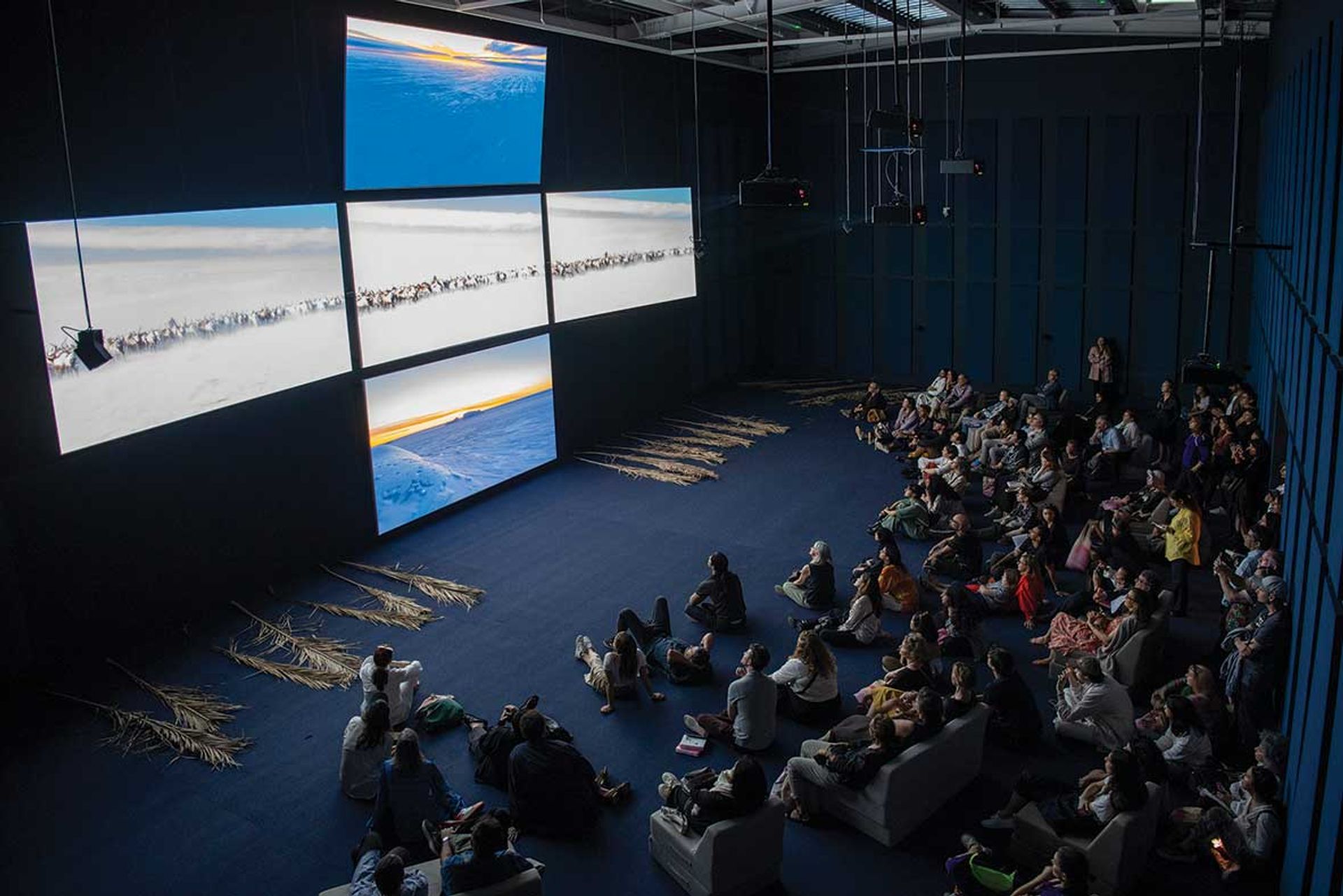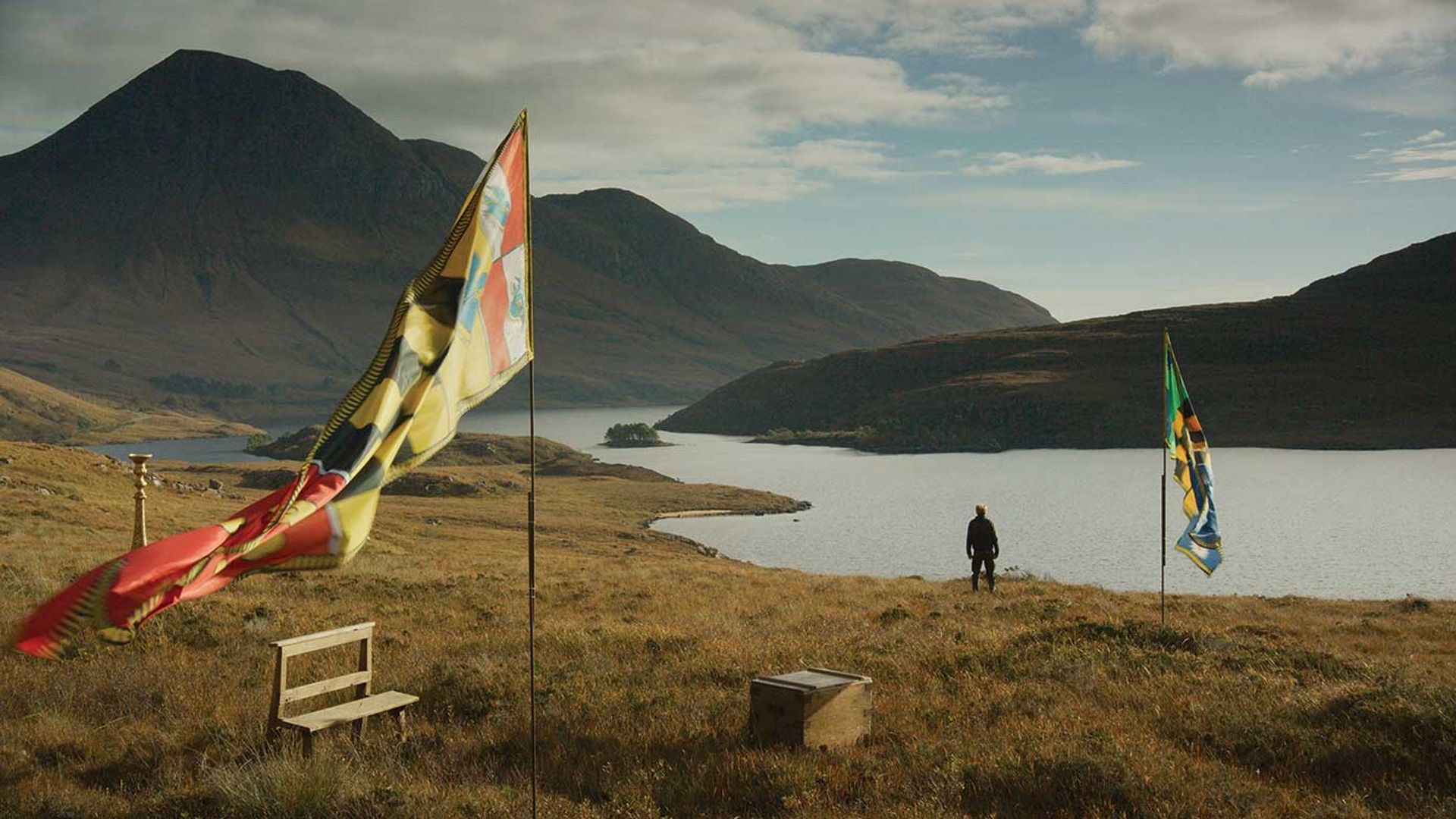The British-Ghanaian artist John Akomfrah has been pushing the boundaries of film for more than four decades. Having started out with experimental documentaries such as Handsworth Songs (1986)—which looks at the British race riots of the early 1980s—he has in more recent years developed a reputation for richly layered, multiscreen installations exploring topics such as climate change, colonialism and time. Akomfrah’s work is intensely collaborative; he co-founded the Black Audio Film Collective in 1982, and then Smoking Dogs Films in 1998.
Akomfrah was knighted last year, and 2024 brings yet another major milestone as he prepares to represent Great Britain at the Venice Biennale. This follows on from his 2019 contribution to the inaugural Ghana pavilion in Venice. In the run-up to this year’s Biennale, Akomfrah has released a new work, Arcadia (2023), exhibited first at the Sharjah Biennial and now in an edited form at The Box in Plymouth, UK. The film, shown across five screens organised in the shape of a cross, traces the formation of the New World and highlights the migrations of—among other things—people, commodities, plant life and diseases (known as the “Columbian exchange”) that played a role. Partly a response to the Covid-19 pandemic, Arcadia also leaves, like so many of his films, a lot open to interpretation. And that, Akomfrah says, is exactly how he wants it.
The Art Newspaper: You have talked about how the ideas behind the film Arcadia changed a lot over the course of the research process. How would you describe the final product to someone who is seeing it for the first time?
John Akomfrah: I think my ideal viewer watching for the first time should think, “Okay, I’m here to watch something about how the New World was opened up.” And then think, “Oh, but this isn’t what I meant by [that] at all.” In other words, I want people who are interested in the drama of the colonial adventure to realise that not all of it is entirely the responsibility of human beings.

Fateful crossing: the film Arcadia (2023), screened across five channels set out as a crucifix. The film, exploring the story of European colonialism, was premiered at the Sharjah Biennial last year and is now showing at the Box in Plymouth
Photo: Motaz Mawid; courtesy Sharjah Art Foundation © Smoking Dog Films
Non-human life is a hugely important part of this film—I have seen you discuss the importance of wind, for example. Can you talk a bit about that?
The discovery of the trade winds by the Spanish and the Portuguese off the west coast of Africa was a game changer. That’s what made the journey to the New World possible. Before that, people dreamt it, but it just wasn’t a thing. You needed the enabling agency of wind. And the trade winds have always been there, we just didn’t realise.
There is also an interesting interplay between the beautiful and the threatening, as seen for example with the quite captivating images of microorganisms. Was that completely shaped by your experience of Covid?
Completely. Covid made all the difference. I’ll let you into something else. I was watching a completely inane programme on YouTube, with two young South African adventurers in Guatemala, wandering around, and they come across this place where all these [skeletons] are coming out of the ground, and they’re like, “Oh wow, how did this happen? They look old!” And I suddenly thought, oh my God, they are in one of the Aztec or Inca mass graves from the 16th [or] 17th century, and they had no idea. It suddenly connected with the narrative from the Mayflower [the ship that transported the Pilgrims from England to the New World in 1620], with the early accounts that [said] when they arrived there was no one around. But the question we hadn’t asked ourselves was: why?
There is a phrase that repeats in the film: “death, dreams”. What is the significance of this?
I try to listen to premodern voices a lot. And “death, dreams” comes from the Roman writer Artemidorus. He wrote a book that interprets dreams, and I thought this was an interesting way of piecing together narrative without necessarily being overly prescriptive. Because the dreams of flight—which have basically haunted the European imagination, really since the 12th century, since the chivalric codes begin to emerge—are absolutely central to this colonial adventure.
A term you have spoken about before is the “affective economy”. You care quite passionately about how people feel when they see your work. How would you describe that in relation to this project? And is there a risk with emotional storytelling?
There is. But I think what I’m interested in more and more is constructing memorials that are about the inauguration of affective economies. And that’s it—just inaugurating them so that people can explore them, get into them, try to walk the maze of them. I don’t really want any more than that because I fundamentally believe that we all have the capacity, if the tools are provided for you, to walk through the labyrinth of solitude yourself and make sense of those things. And also decide what you don’t think is worth making sense of.
How did it feel to be showing Arcadia in Plymouth as opposed to Sharjah? I understand you tweaked it slightly for the former.
Not just slightly. It’s, I think, about 15 minutes shorter. Some sections have been more violently juxtaposed than they were before. Because [before] I just felt like I needed to respect many of the narratives, but I think you can be overly respectful as well, and it felt to me as if I’d been maybe a little cautious. I still like [the original] a lot, but this feels more audience friendly—put it that way.
You have talked before about wanting to push the limits of cinema. Do you think that you are close to the edge of that journey?
Oh, out of the room! In the sense that almost everything in [Arcadia] owes something to cinema one way or another, but just rendered slightly strange, slightly unusual. There are “actors” in there, but they don’t do any of the things standard actors are supposed to do. And they don’t come on with that experience. The main figure in there is my production designer. That’s him in a black coat. We started shooting, and I thought, “Keith, stay there!”
And [it’s] also just things that people fuss over in cinema—the story, the script. And because, as I’ve also said probably boringly too many times, it’s about trying to work around the Aristotelian presets of cinema—the sense that it has to have a dramatic flow, all of that. The whole thing just bores me to shit. And I understand it, most of my best friends still work in the cinema, but it’s just like, you know what, let’s just leave that here for a minute.
Clocks are a recurring motif in Arcadia, and in your practice more broadly the lines between “then” and “now” regularly seem to blur. How do you see time—the present and the past—in your work?
I’m more and more trying to relax on the protocols, the decorum and the conventions. So one is to cultivate a state of unpreparedness for as long as possible. Because you’re never free from the phantoms, you know? I can’t look at a scene without thinking, “Oh, that’s a [French film-maker Robert] Bresson way of looking.” I can’t—it’s too late now. I’m completely contaminated by that history of what I’ve watched and listened to. So a state of unpreparedness is absolutely central because it’s a way of strategically forgetting momentarily, or dreaming that you’re in this thing for the first time. And that’s important. It’s important because otherwise nothing new happens.
You’ve got a big year with the Venice Biennale coming up. How do you prepare for a project like that?

Still from Arcadia (2023)
© Smoking Dogs Films. Courtesy Smoking Dogs Films and Lisson Gallery
All of them start in the finished other, literally. So the Biennale will have a lot to do with Arcadia, a lot to do with the things I thought needed further exploring from Arcadia, the things I thought we hadn’t pressed enough, the things that suggested themselves when Arcadia finished. They will all be the baggage that we take on to the next one. So the first meetings with people—some of them are old collaborators—will be about, “Remember that? Well, let’s do that, because we didn’t get it on this one, so let’s go there.”
• John Akomfrah: Arcadia, The Box, Plymouth, until 2 June










